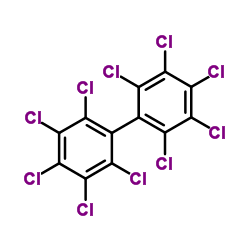Decachlorobiphenyl

Decachlorobiphenyl structure
|
Common Name | Decachlorobiphenyl | ||
|---|---|---|---|---|
| CAS Number | 2051-24-3 | Molecular Weight | 498.66 | |
| Density | 1.8±0.1 g/cm3 | Boiling Point | 466.0±40.0 °C at 760 mmHg | |
| Molecular Formula | C12Cl10 | Melting Point | 310℃ | |
| MSDS | Chinese USA | Flash Point | 232.7±24.7 °C | |
| Symbol |


GHS08, GHS09 |
Signal Word | Warning | |
|
Source determination of highly chlorinated biphenyl isomers in pine needles - comparison to several PCB preparations.
Environ. Pollut. 143(1) , 46-59, (2006) The isomer specific composition of 13 technical PCB formulations of different origin and of pine needles was analyzed using GC/MS and HRGC/HRMS. Nonachlorinated biphenyls were identified in 11 among 13 formulations analyzed, with the highest abundance found f... |
|
|
A simultaneous extraction method for organophosphate, pyrethroid, and neonicotinoid insecticides in aqueous samples.
Arch. Environ. Contam. Toxicol. 68(4) , 745-56, (2015) A method was developed for the extraction and analysis of 2 organophosphate, 8 pyrethroid, and 5 neonicotinoid insecticides from the same water sample. A salted liquid-liquid extraction (LLE) was optimized with a solid-phase extraction (SPE) step that separat... |
|
|
A novel fully automated on-line coupled liquid chromatography-gas chromatography technique used for the determination of organochlorine pesticide residues in tobacco and tobacco products.
J. Chromatogr. A. 1374 , 273-7, (2014) In this study, a novel fully automated on-line coupled liquid chromatography-gas chromatography (LC-GC) technique was reported and applied for the determination of organochlorine pesticide residues (OCPs) in tobacco and tobacco products. Using a switching val... |
|
|
Distribution and uptake pathways of organochlorine pesticides in greenhouse and conventional vegetables.
Sci. Total Environ. 505 , 1142-7, (2014) The application of greenhouse vegetable cultivation has dramatically expanded worldwide during the last several decades. However, little information is available on the distribution and uptake of pesticides in greenhouse vegetables. To bridge this knowledge g... |
|
|
Development and comparison of two multi-residue methods for the analysis of select pesticides in honey bees, pollen, and wax by gas chromatography-quadrupole mass spectrometry.
Talanta 140 , 81-7, (2015) One of the hypotheses that may help explain the loss of honey bee colonies worldwide is the increasing potential for exposure of honey bees to complex mixtures of pesticides. To better understand this phenomenon, two multi-residue methods based on different e... |
|
|
Phytoextraction of DDT-Contaminated Soil at Point Pelee National Park, Leamington, ON, Using Cultivar Howden and Native Grass Species.
J. Environ. Qual. 44 , 1201-9, (2015) A field investigation was conducted at three dichlorodiphenyltrichloroethane (DDT)-contaminated areas in Point Pelee National Park (PPNP), Leamington, ON. cultivar Howden and three native grass species, (Michx.) Nash (little bluestem), L. (switchgrass), and (... |
|
|
Integrated sediment quality assessment through biomarker responses and bioavailability measurements: Application in Tai Lake, China.
Ecotoxicol. Environ. Saf. 119 , 148-54, (2015) A weight of evidence (WoE) framework has been applied to assess sediment quality of a typical freshwater lake, Tai Lake in China, where the sediments were contaminated by various chemicals but showed no acute lethality to the benthic invertebrate, Chironomus ... |
|
|
Pathways and products of the degradation of PCBs by the sodium dispersion method.
Chemosphere 68(5) , 871-9, (2007) Nine polychlorinated biphenyl (PCB) congeners (2-chlorobiphenyl, 3-chlorobiphenyl, 4-chlorobiphenyl, 2,3,4-trichlorobiphenyl, 2,2',5,5'-tetrachlorobiphenyl, 2,3',4,4',5-pentachlorobiphenyl, 3,3',4,4',5-pentachlorobiphenyl, 2,2',4,4',5,5'-hexachlorobiphenyl, a... |
|
|
Comparative study on accumulation and elimination of hexachlorobiphenyls and decachlorobiphenyl in mice.
Bull. Environ. Contam. Toxicol. 25(2) , 181-7, (1980)
|
|
|
Chemiluminescence emission during reactions between superoxide and selected aliphatic and aromatic halocarbons in aprotic media.
J. Biolumin. Chemilumin. 11(1) , 9-22, (1996) The reactions between superoxide free radical anion (.O2-) with the halocarbons CCl4. CHCl3, BrCH2CH2Br(EDB), decachlora-biphenyl (DCBP), and 2,3,7,8-tetrachlorodibenzo-p-dioxin (TCDD) in dimethyl sulphoxide (DMSO) results in the emission of chemiluminescence... |